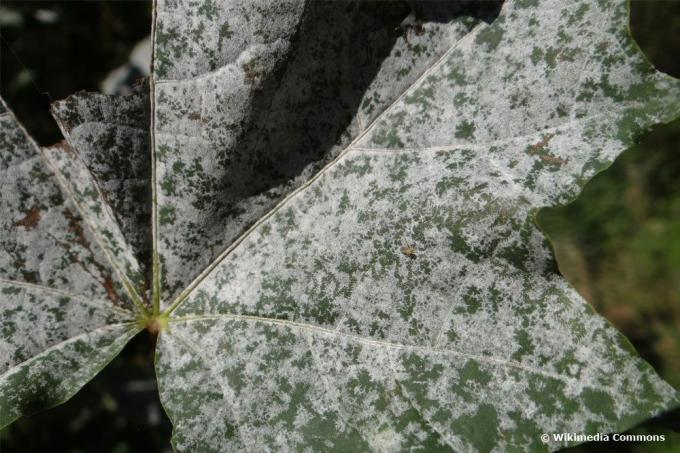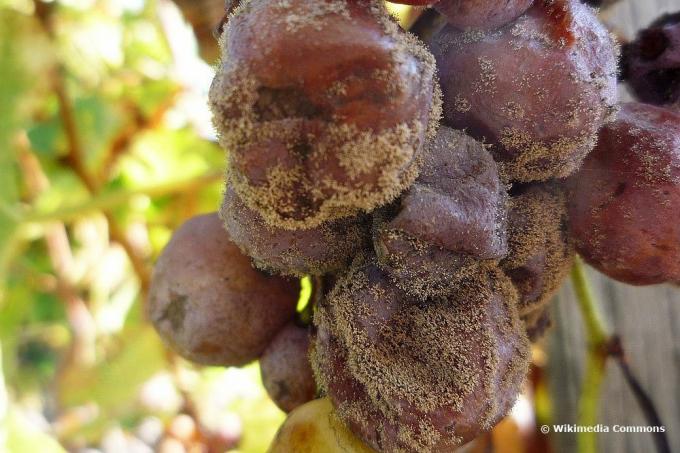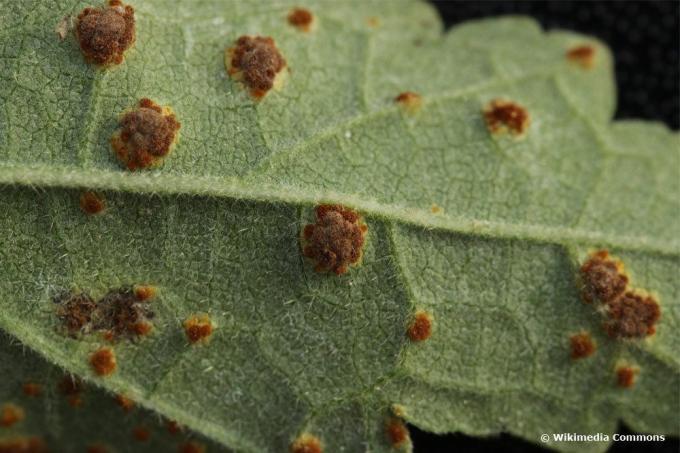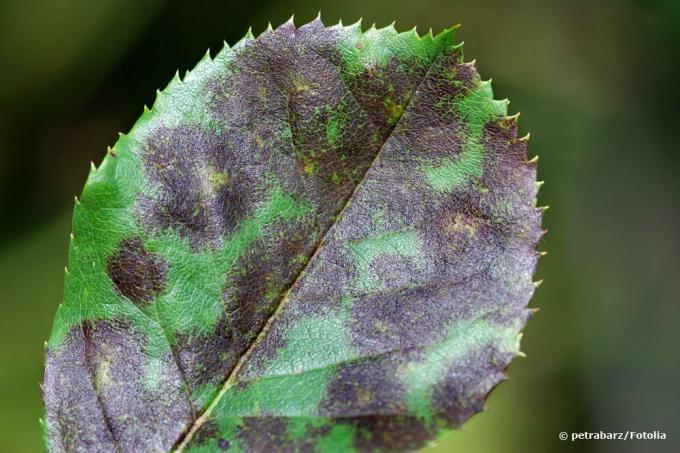
table of contents
- Illnesses caused by incorrect care
- Fungal diseases
- Bacterial and viral diseases
Like all living things, indoor plants also get sick. These 18 diseases are common. Their causes are varied and range from errors in watering and fertilizing to infection with pathogens such as fungi and bacteria.
Illnesses caused by incorrect care
Many diseases in indoor plants are caused by simple mistakes in care. Incorrect watering and fertilization or an unsuitable location makes both foliage and flowering plants difficult - they get just as sick as a person who eats one-sidedly over a long period of time or does not go into the sun goes. These diseases in indoor plants are noticeable in external features, they can often be read from the leaves. A healthy leaf (and therefore a healthy plant) has a firm structure and flawless leaf edges and tips. Changes always indicate a grievance that needs to be remedied.
Note: Once deficiency diseases appear, further infections - for example with fungal, bacterial or viral diseases - are not far off. Indoor plants weakened by improper care are more susceptible to additional infection.
Leaf wilt

Are the leaves of your houseplants hanging down and appearing to be wilting? Is their color unchanged? Then the plant suffers from leaf wilt due to lack of water. Fix the dryness by watering the plants. The leaves should then straighten up again within a few hours. If this is not the case, there are other diseases behind this phenomenon.
Brown leaf spots
Brown spots on the leaves have different causes. You can often tell what is causing the discoloration by its placement. Brown leaf margins, for example, are caused by
- too little or too much water
- Overfertilization
- used earth
- dry air
If, on the other hand, only the tips of the leaves turn brown, you are either keeping the root ball too dry or the humidity is too low. The problems mentioned can be remedied through correct care that meets the requirements of the respective plant. However, once brown leaves do not turn green again, so you should cut them off.

Tip: With potted plants, make sure there is drainage in the planter so that excess water can run off immediately. Do not leave this in the planter, but remove it within half an hour after watering.
Chlorosis
the Chlorosis is a typical leaf disease on poorly supplied house plants. It is characterized by the pale to yellowish leaves that appear bleached, with the leaf veins typically remaining bright green. The disease appears insidiously.
The causes are:
- Use of hard (calcareous) irrigation water
- resulting iron deficiency
- Lime prevents the roots from absorbing iron
- Undersupply also possible due to waterlogging
- causes rotten roots that no longer absorb nutrients

In case of waterlogging, you should immediately pot the plant in question, remove the wet substrate and rotting roots and repot the plant in fresh soil. Then keep them drier and, above all, do not leave excess irrigation water in the planter or on the saucer.
If the chlorosis results from a lack of iron, you should also repot the plant in question in fresh substrate. Also fertilize it with iron chelate (from a specialist store) to compensate for the deficiency. In the future, only use soft irrigation water, either well-filtered tap water or rainwater.
Yellow leaves
If the leaves do not fade, but instead turn bright yellow, you should act quickly. The yellow color indicates significant care errors that must be remedied quickly - otherwise the plant will soon throw off all of its leaves and threaten to perish.
Possible causes for the yellowing are:

- Pouring over / waterlogging
- Nitrogen deficiency
- too dark location / lack of light
- too cool or too warm location
As a first measure, check the moisture content of the substrate: Does it feel damp or even wet? Does it dry off in between or do you keep it moist continuously? Then you have probably watered your plant too much. Repot them in fresh substrate and keep them drier. Even if there is a lack of nitrogen, it helps to put it in nutrient-rich soil, but if there is a lack of light or the temperature is not suitable, a change of location takes place.
Bud and flower fall
Illnesses in indoor plants caused by incorrect care do not only show up on the leaves. Many houseplants - such as some types of cactus or azaleas - often shed buds and flowers when there is a lack of light or an incorrect supply of water and nutrients. In the case of these signs, find out about the specific needs and requirements of the plant in question and take care of them accordingly. The following are particularly important:
- Location / lighting conditions
- temperature
- Humidity (many tropical plants need high humidity)
- Amount of water
- fertilization
- wintering
Some houseplants cannot tolerate warm wintering when there is a lack of light and dry heating air. You must place these specimens in a cool and light place, then the buds will be preserved.
Cork growths
Cork growths show up as brownish, corky and slightly raised leaf spots. They are more common on orchids and pelargoniums when these
- getting too much water in too little light
- are exposed to strong temperature changes
- or the moisture content in the substrate often fluctuates strongly.
The affected leaves fall off after a while. Remove the diseased leaves, make the plant lighter and ensure an even water supply, with which the substrate dries off in between.
Silvery leaf spots
If your houseplants show silvery spots on the leaves, the location is too sunny - the leaves are sunburned. In some plants, the phenomenon also manifests itself in the form of red or brown leaf spots. Remove the blotchy leaves and place the plant in question in a bright spot, but not in direct sunlight. Shading over the midday hours is particularly useful in a location with intense midday sun. Also, avoid watering the leaves on plants that need to be sunny. The water droplets act like a magnifying glass.
Root rot

Root rot always occurs as a result of excessive watering or even waterlogging. Fungi and bacteria settle on the permanently moist roots, causing the plant to rot from below. An infestation is initially noticeable above ground in wilting phenomena: leaves and shoots seem to wither, although they get enough water. The opposite is the case: the plant wilts because it receives too much water. Now you need to act quickly to prevent the growth from shrinking:
- Pot out the plant.
- Remove any soil adhering to the roots.
- Cut away the black, rotting roots.
- Use a sharp, clean knife for this.
- Dust the interfaces for disinfection with charcoal.
- Put the plant in fresh substrate.
Furthermore, the above-ground shoots also have to be cut back because the remaining roots can no longer supply all of them.
Tip: Damaged roots are often the reason for the notorious growth of the accordion in orchids. Cut away the diseased roots and transfer the plant to fresh substrate.
Fungal diseases
Illnesses in indoor plants caused by fungi often occur as a result of incorrect care or location, as the pathogens attack weakened plants more easily. In such a case, you not only have to treat the actual illness, but also correct supply errors and / or an unsuitable location.
Tip: Strengthen the defense of your indoor plants against fungi by regularly spraying or watering them with freshly made horsetail brew. To do this, let 500 grams of finely chopped horsetail soak in five liters of water for 24 hours, then simmer the brew for half an hour and then strain it off. Use it cooled as a spray cure.
Leaf spot disease

The so-called leaf spot disease, which is typically characterized by scattered yellow to brown leaf spots, is caused by various fungi. These are sometimes surrounded by dark spore beds and gradually merge as the infection progresses. When the whole leaf is finally colonized, it falls off. Leaf spot fungi appear
- Waterlogging
- too high humidity
- too cold irrigation water
- cold "feet" (e.g. B. Planter stands directly on a cold stone floor)
- or stagnant air (lack of ventilation)
on. Sick parts of the plant must be cut away.
Powdery mildew

Powdery mildew is manifested by a white, powdery and wipeable coating on the upper side of the leaves. If the fungal infection progresses, other parts of the plant - such as the underside of the leaves, stems, shoots and even flowers and fruits - are also affected. This fungal disease occurs mainly in dry and warm weather (which is why the gardener also speaks of the "fair weather mushroom") and can basically attack almost all indoor plants. The cause is blown fungal spores, for example in plants over summered on the balcony.
A spray cure with milk (one part fresh whole milk, nine parts soft water) or horsetail brew helps against powdery mildew. If possible, cut away diseased leaves and other parts of the plant to prevent further spread. Incidentally, roses, which are susceptible to diseases caused by fungi, are particularly affected.
Wrong mildew

Downy mildew (“bad weather fungus”), on the other hand, occurs in damp and cool weather / appropriate room temperature. An infestation is indicated by a white-gray to gray-blue coating on the undersides of the leaves, while whitish or red spots appear on the upper sides of the leaves. Infested parts of the plant die over time and must therefore be cut back. Spray infested house plants with fresh, undiluted horsetail broth.
Gray mold (botrytis)
If your houseplants seem to be downright moldy in different parts, then the gray mold rot caused by the fungus Botrytis cinerea is at work. A white to gray-brown, dusty coating on leaves, stems or flowers is typical. Other parts of the plant can also be affected because the gray mold spreads very quickly. The causes of an infection are mostly

- Splashing water
- cool and humid indoor air
- too high humidity
Remove diseased parts of the plant and place the affected plant in a warm, light and airy location. Reduce the humidity.
Rust diseases
Rust diseases are caused by various fungi of the genus Pucciniales and can be easily recognized by their characteristic damage pattern.

- orange to brownish bumps on the underside of the leaves
- these are about the size of a pin
- often light spots on the upper side of the leaves
- these often only appear in the further course of the infection
- Leaf spots and spore beds turn black over time
Rust fungi get to indoor plants via the air - for example through an open window. Remove the infected leaves and sprinkle the affected plants with horsetail brew or fern tea (made from bracken or worm fern, for preparation see horsetail broth).
Sooty mildew
A blackish, dirty-looking and wipeable coating on the upper side of the leaves is due to sooty mildew. This disease occurs only in connection with an infestation with sap-sucking pests such as leaf, wool and Scale insects because sooty fungi feed on the sweet legacy of the insects - the honeydew. An infection is treated as follows:
- Cut away heavily blackened leaves
- Wipe slightly blackened areas with a damp cloth
- Fight pests
Bacterial and viral diseases
In addition to fungi, bacteria and viruses also cause diseases in indoor plants. These pathogens are more dangerous because they often cause the affected plant to die within a very short time. A remedy or treatment option is not always available. At the beginning of the disease, you may be lucky and can save the plant with a strong pruning. In many cases, however, it can only be disposed of.
Bacterial wet rot
The bacterial wet rot occurs in cyclamen, Dieffenbachia and Zimmerkalla. The disease is initially characterized by a rotting trunk base, the putrefaction inevitably spreads in the further course.
Frizziness
This bacterial disease mainly affects fuchsias and pelargoniums. You can recognize them by stunted, unnaturally curled leaves. Caution: There is a fungal disease of the same name that occurs in peach trees. However, they are different pathogens.
Mosaic disease

The mosaic virus attacks flamingo flowers (anthurium), orchids, hydrangeas, gloxinias and the knight's star. Typical symptoms are different light and dark green leaf spots that look like a mosaic.
Oil stain disease
Oil spotting is also a leaf blotch disease, but it is caused by bacteria rather than fungi. The infection appears particularly on pelargoniums, begonias, and ivy. The glassy, light or dark oil stains on the upper sides of the leaves and on the stems are characteristic. Cut back diseased plant material vigorously. However, if the infestation is severe, the plant must be disposed of.
